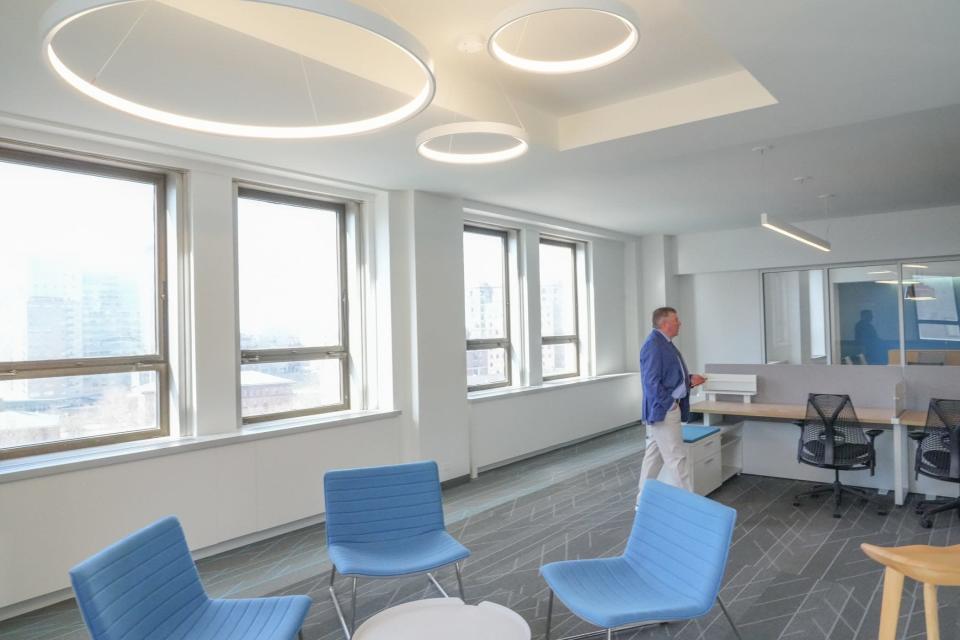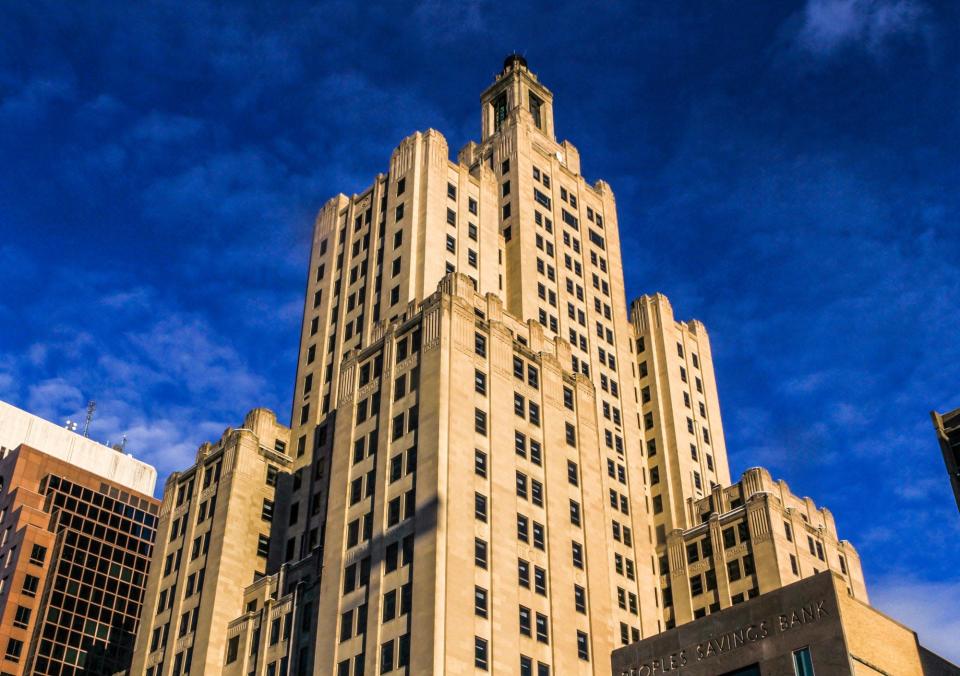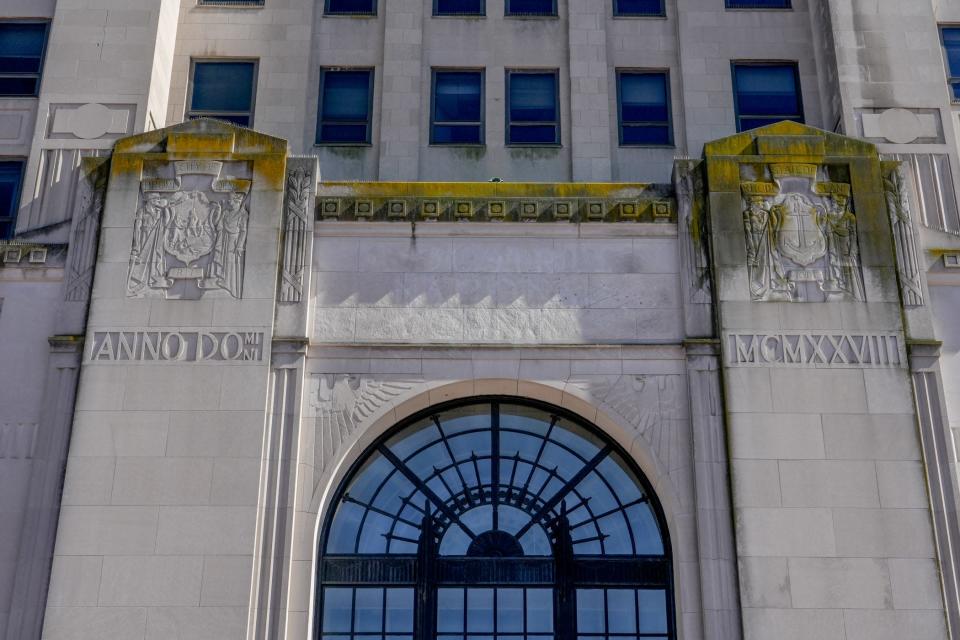Table of Contents
PROVIDENCE — The owner of Rhode Island’s tallest and most recognizable building reached an agreement with city and state leaders Tuesday on a deal to bring the tower – known locally as the “Superman Building” – back to life nearly a decade after it was left vacant.
The $220-million redevelopment plan would save the landmark Industrial Trust tower from being torn down or continuing to cast an economic shadow over downtown.
Instead, with around $41 million in state and local financing, David Sweetser of High Rock Development plans to turn it into an apartment building with event and commercial space in what used to be the grand bank lobby on the ground floor.
Industrial Trust Company: What to know about Providence’s Superman Building

“It is going to light up a building that has not been lit in almost a decade,” Gov. Dan McKee told business, political and union leaders at a State House news conference. “What is that going to mean for downtown Providence? It is going to breathe life into it.”
Providence Mayor Jorge Elorza said the redevelopment of the “Superman Building” would help bring needed housing and help transform a downtown struggling with the loss of traditional office workers.
“The Superman Building is a building that we all have a connection to; we all feel attached to it,” Elorza said. “In no small way, it is a symbol of our entire state.”
Where bank executives once toiled, building owner High Rock wants to build 285 rental apartments.
Most of them would be rented at market rates, but at least 20% would be deed-restricted for people making between 80% and 120% of the average median Income.
Whether those roughly 57 apartments would actually be “affordable” is likely to be the subject of debate, but the income restrictions will allow the project to get financial help from Rhode Island Housing.

Superman Building: Project funding and framework
The deal
The public contribution to the redevelopment project, while significant, is smaller than the $48 million High Rock was asking for last year, according to Commerce Secretary Stefan Pryor.
And it is smaller than the $75-million incentive package High Rock asked for in 2013 to convert the tower to apartments.
The deal announced Tuesday includes $26.2 million from the state and $15 million from the city.
The city’s contribution is made up of a $10-million low-interest loan from the Providence Redevelopment Authority and a $5-million municipal grant.
The city is also offering High Rock a new 30-year break (known as a tax stabilization) on the Industrial Trust Tower’s property tax bill.
The state funding is made up of $15 million in Rebuild Rhode Island tax credits, $5.7 million from a Commerce Corporation “First Wave” fund and $5.5 million from two Rhode Island Housing programs.

To help make the deal happen, the Rhode Island Foundation has agreed to lend High Rock $15 million against the state tax credits it should receive. (Under the Rebuild program, state issues the tax credits only when a project is complete.)
The federal government is also expected to chip in to the project with $22 million in historic-preservation tax credits and $2 million in New Market tax credits.
All told, the plan announced Tuesday includes $65 million in public financing.
High Rock is expected to spend $32 million in cash on the conversion and borrow $116 million to fund construction.
Previously: RI in ‘heavy negotiations’ to revive Providence’s Superman Building; McKee is optimistic
Crumbling face of an icon: Can ‘Superman’ be saved?
The building
Zachary Darrow, a lawyer working for Sweetser, said demolition work on the interior of the building should begin in five to six months and take around six months to finish. The entire project should take around 30 months to complete.
High Rock is still finalizing what it wants to put in the lower floors to complement the apartments, but Darrow noted that the lobby needs to be restored to qualify for historic tax credits.
“It is our intention to integrate some form of community-based program,” Darrow said.
The agreement with High Rock sets out what the state and city are willing to pay now, but that doesn’t mean the public subsidy could not increase if construction costs rise, as has happened with large projects such as the Worcester Red Sox stadium.
Darrow said the $220-million cost estimate already accounts for post-pandemic inflation.
“We are very confident we have worked on getting good current numbers and accounting for the market shifts that could occur,” he said.
Would the state pick up the tab if costs rise further?
“At this time we don’t anticipate that problem,” Pryor said. “If issues arise we will address them at that time.”
Asked what changed to make a deal possible now after nine years of failure, Pryor said the red hot real estate market had a lot to do with it.
“One of the factors is the strength of the residential market,” he said. “The fact that residential lease rates could be computed at the levels they are at… made the project more affordable.”

Reaction
Arnold “Buff” Chace, managing partner of Cornish Associates, was part of the team High Rock hired back in 2013 to reimagine the “Superman Building.”
“The addition of hundreds of housing units at differing price levels and more commerce into this architectural gem will create a high pulse on Westminster and Fulton streets and breathe new life into our city’s central plaza,” Chace said in an email.
Not everyone in the city was so enthusiastic about the deal.
“Correction: Providence taxpayers would extend a 40-year! low interest $10M loan + $5M grant + generous tax stabilization agreement. Maybe we can throw in a convertible Bentley, too,” mayoral candidate Gonzalo Cuervo tweeted.
Providence state Sen. Sam Bell said the forgone property taxes in the 30-year tax treaty being discussed “may well tip the city into bankruptcy.”
This article originally appeared on The Providence Journal: Superman Building: How Providence icon will get a $220 million revamp
